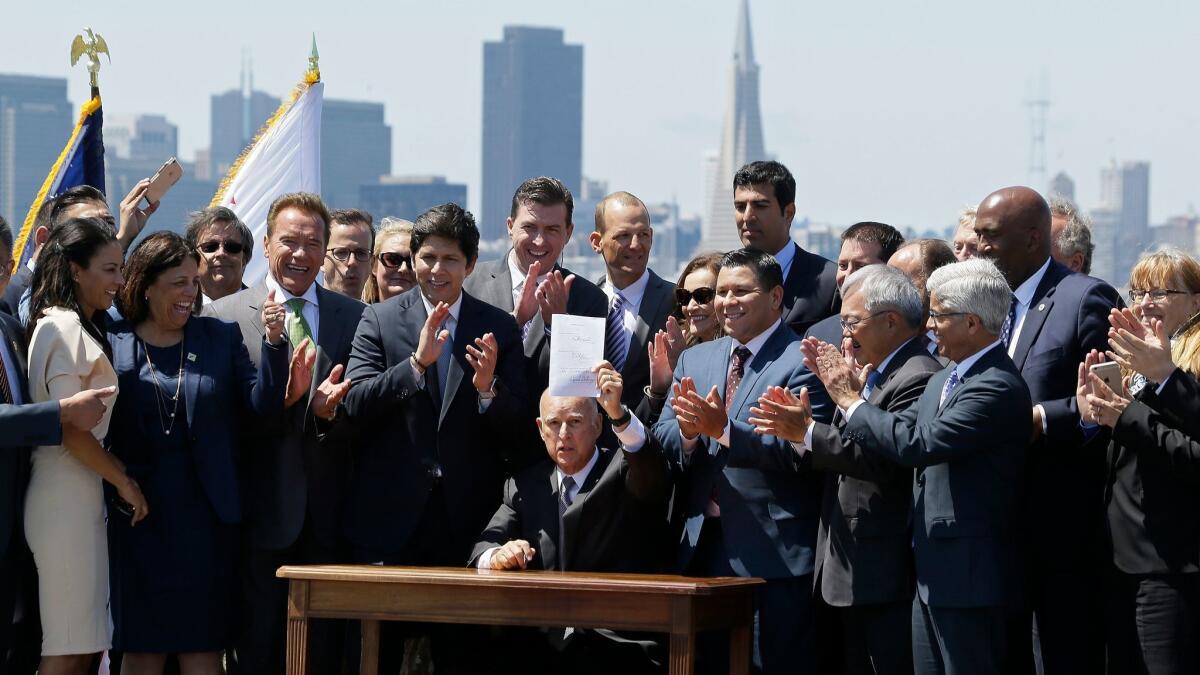California cap-and-trade program gets a shot in the arm with strong permit auction results

- Share via
A month after a bruising political battle to extend California’s cap-and-trade program, the state received a big vote of confidence in the policy’s future.
Cap and trade requires oil refineries, food processors and other facilities to buy permits to release greenhouse gas emissions into the atmosphere, and state regulators auction off the permits several times a year.
During August’s auction, every emission permit offered by the state was sold, and prices reached their highest level since the program launched five years ago.
The auction results, announced Tuesday, were the first since Gov. Jerry Brown signed legislation continuing cap and trade until 2030, erasing some of the political and legal uncertainty that had dogged the program.
“Today’s results affirm the courage of the votes taken to secure the future of cap and trade in California,” Erica Morehouse, a lawyer with the Environmental Defense Fund, wrote on her organization’s website.
During each auction, the state sets a minimum price per permit, which was $13.57 in the latest round. The bidding led to a final price of $14.75, the highest it’s been above the minimum in years.
The results were encouraging after so much turmoil with the program, said Chris Busch, research director at Energy Innovation, a San Francisco think tank.
“It’s a strong vote of confidence in the long-term certainty of the system,” he said.
However, some analysts are concerned about how the state will meet its ambitious goal for slashing emissions to 40% below 1990 levels by 2030.
Even though the cost of permits has been rising, it may not happen fast enough to provide an adequate financial incentive for companies to clean up their operations, said Danny Cullenward, a Stanford University energy economist.
State regulators should take steps to ensure they’re auctioning the right number of permits because making too many available could allow too many emissions, he said.
“Lurking in the background is a much more serious issue,” he said.

A breakdown of the cap and trade program.
The latest auction could generate roughly $640 million in revenue, analysts estimated.
Auction revenue is spent by the state on projects intended to reduce emissions, such as mass transit and electric vehicle rebates. It’s also being used by Brown to build the bullet train from Los Angeles to San Francisco.
Lawmakers will debate how to spend about $1.4 billion in cap-and-trade revenue in the coming weeks, including some leftover money from the last fiscal year and more cash expected over the following one.
Senate President Pro Tem Kevin de León (D-Los Angeles) wants to spend about $1 billion to help retire old, dirtier engines, replacing tractors, trucks and cars with newer, more efficient models.
“We have a historic opportunity to bring businesses, conservatives and liberals alike together on the issue of clean air,” he said.
Twitter: @chrismegerian
ALSO
xx
xx
Updates on California politics
More to Read
Get the L.A. Times Politics newsletter
Deeply reported insights into legislation, politics and policy from Sacramento, Washington and beyond. In your inbox three times per week.
You may occasionally receive promotional content from the Los Angeles Times.











